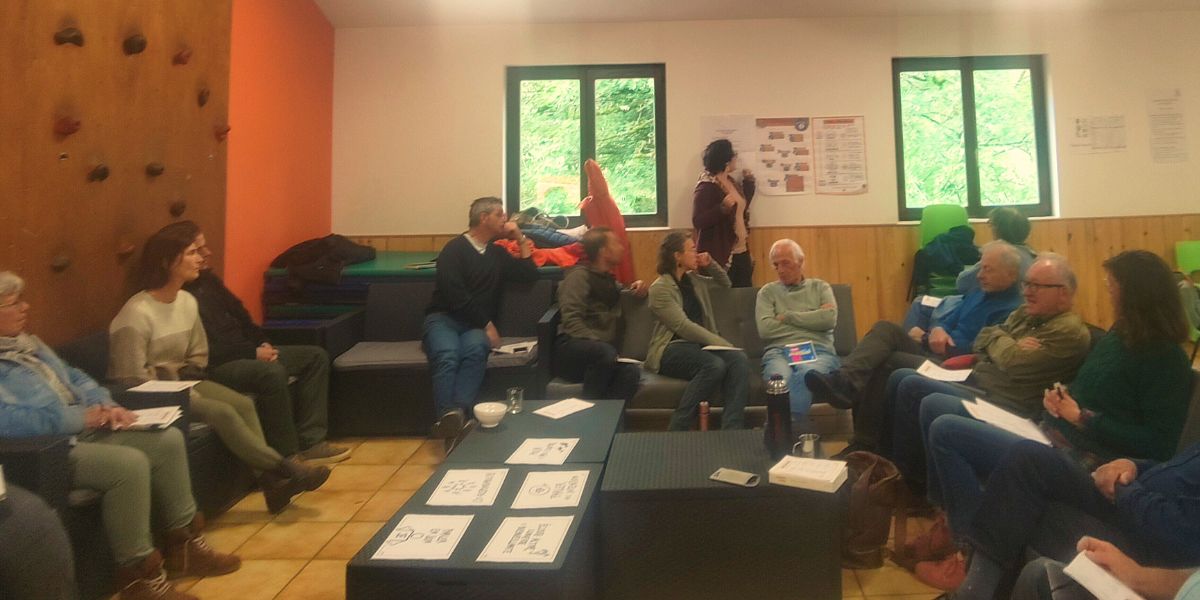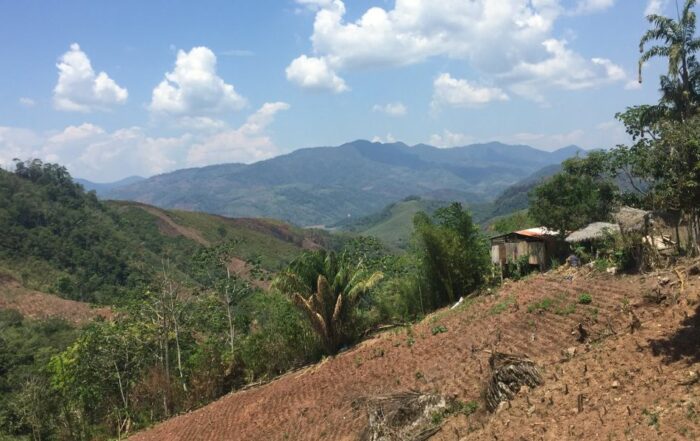On 5 October, the general meeting of the GFC Les Hauts Bois, created by the SEVE project, was held. It was a convivial occasion with plenty of discussion about the GFC’s prospects and the election of one of the co-managers!
An agenda filled with topics and opportunities for discussion
The general meeting began on the evening of Saturday 4 October at the Berlats gîte with a potluck dinner, which marked the start of the meeting with a moment of conviviality and sharing. It is during these moments of sharing that GFC members and active participants can meet, exchange ideas and enjoy being together in a place surrounded by forests. Before the meal, some of the members went for a walk in the GFC forest in the commune of Espérausses, in particular to observe the mushrooms that mark the arrival of autumn.
On Sunday, the general meeting was held throughout the day. The financial statements were displayed in the room so that everyone could consult them and ask questions if necessary. After a welcome coffee and croissants, the morning began with a presentation of the new members and a round table discussion, followed by a presentation of the principles of sociocracy.
This presentation allowed newcomers to familiarise themselves with the principles of sociocracy and to demonstrate all the gestures used in sociocracy, as well as the process of the election without candidates that took place in the afternoon. To conclude, a practical exercise was held in the form of a fun consent vote.
After a convivial lunch, the afternoon began with three small group workshops. The workshops focused on the following topics: life at GFC, committee life, and the forest committee.
Following the workshops, the election without candidates was held.
Election without candidates, a tool of sociocracy
In order to elect one of the three co-managers whose term of office was coming to an end, the GFC proceeded by election without candidates, a sociocratic election method adopted by the GFC. In an election without candidates, no one stands as a candidate. The mandate, duties and term of office are explained, as well as the qualities sought in the person to be elected. Next, a round table discussion is held, during which each participant indicates who they would like to elect and why. At the end of the round table discussion, the potential candidates are listed according to all the proposals. A proposal is made in favour of one of the listed candidates, and the assembly proceeds to a round of objections. The idea is not that everyone agrees, but that no one says ‘no’, i.e. raises an objection to the election of a person. Objections should not be based on personal preference, but should raise an obstacle to the performance of the duties, for example: a lack of time on the part of the proposed person, a crucial skill missing for the position, etc.
Objections are raised and can be answered and lifted. If no objections are raised or remain, the person is elected. If objections remain (including from the elected person), then the process is restarted with another person on the list.
This process, which stems from participatory governance, makes it possible to elect someone without anyone opposing them, thereby legitimising the elected person and making them accountable. It also avoids the pitfall of electing a candidate because they put themselves forward or consider themselves to be good for the job, and allows a candidate to be elected because they are deemed to meet the criteria required for the position.
On 5 October, the general meeting of the GFC Les Hauts Bois, created by the SEVE project, was held. It was a convivial occasion with plenty of discussion about the GFC’s prospects and the election of one of the co-managers!
An agenda filled with topics and opportunities for discussion
The general meeting began on the evening of Saturday 4 October at the Berlats gîte with a potluck dinner, which marked the start of the meeting with a moment of conviviality and sharing. It is during these moments of sharing that GFC members and active participants can meet, exchange ideas and enjoy being together in a place surrounded by forests. Before the meal, some of the members went for a walk in the GFC forest in the commune of Espérausses, in particular to observe the mushrooms that mark the arrival of autumn.
On Sunday, the general meeting was held throughout the day. The financial statements were displayed in the room so that everyone could consult them and ask questions if necessary. After a welcome coffee and croissants, the morning began with a presentation of the new members and a round table discussion, followed by a presentation of the principles of sociocracy.
This presentation allowed newcomers to familiarise themselves with the principles of sociocracy and to demonstrate all the gestures used in sociocracy, as well as the process of the election without candidates that took place in the afternoon. To conclude, a practical exercise was held in the form of a fun consent vote.
After a convivial lunch, the afternoon began with three small group workshops. The workshops focused on the following topics: life at GFC, committee life, and the forest committee.
Following the workshops, the election without candidates was held.
Election without candidates, a tool of sociocracy
In order to elect one of the three co-managers whose term of office was coming to an end, the GFC proceeded by election without candidates, a sociocratic election method adopted by the GFC. In an election without candidates, no one stands as a candidate. The mandate, duties and term of office are explained, as well as the qualities sought in the person to be elected. Next, a round table discussion is held, during which each participant indicates who they would like to elect and why. At the end of the round table discussion, the potential candidates are listed according to all the proposals. A proposal is made in favour of one of the listed candidates, and the assembly proceeds to a round of objections. The idea is not that everyone agrees, but that no one says ‘no’, i.e. raises an objection to the election of a person. Objections should not be based on personal preference, but should raise an obstacle to the performance of the duties, for example: a lack of time on the part of the proposed person, a crucial skill missing for the position, etc.
Objections are raised and can be answered and lifted. If no objections are raised or remain, the person is elected. If objections remain (including from the elected person), then the process is restarted with another person on the list.
This process, which stems from participatory governance, makes it possible to elect someone without anyone opposing them, thereby legitimising the elected person and making them accountable. It also avoids the pitfall of electing a candidate because they put themselves forward or consider themselves to be good for the job, and allows a candidate to be elected because they are deemed to meet the criteria required for the position.






